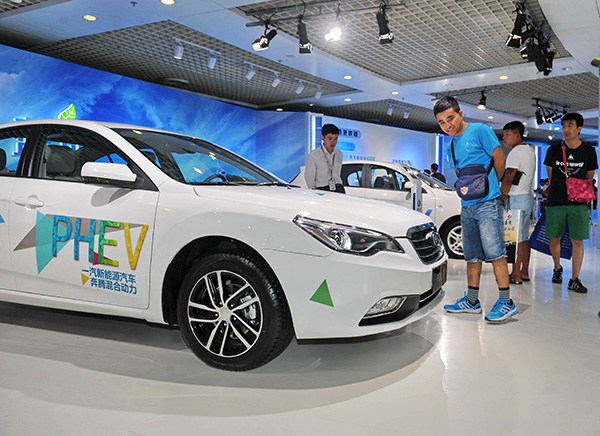
Visitors check a hybrid new-energy car at an auto show in Changchun, Jilin province. (Photo/Xinhua)
China's production and consumption of energy have continually increased during the 12th Five-Year Plan (2011-15), especially the latter, which has experienced an annual average growth rate of about 4.7 percent, almost three times the global average growth.
However, at the same time the efficiency of energy use has constantly been improved; by the end of last year the energy consumption per unit of GDP had declined by 12 percent since 2010.
And over the same period, China's energy structure has witnessed a series of benign changes, as in June nuclear power generated more than 22 gigawatts of electricity, almost doubled that of 2010, and wind capacity reached 104 Gw, nearly one-third of the world's total installed capacity of wind power. China also produced the world's biggest increases in the installed capacity of solar power (over 35 Gw) and hydroelectricity (300 Gw and counting).
In contrast, coal accounted for around 66 percent of China's primary energy consumption in 2014, a reduction of 3.7 percent since 2010. That reduction almost equals Mexico's total energy consumption for last year. However, China still lags behind the European Union and the United States, as the proportion of coal in their primary energy consumption in 2014 was below 20 percent.
China's GDP contributed to approximately 13 percent of the global economy in 2014, but at the expense of about 23 percent of the world's energy consumption. Its extensive development of green energy sources such as the wind power has also caused a considerable waste of natural resources.
Hence, in its next five-year plan, the government should resort to energy restriction, particularly of coal, in order to press ahead with the transformation of the economic structure. The abundance of reserves and relatively low cost have granted coal a central place in China's energy consumption, giving rise to severe environmental pollution. Reducing the use of coal would also meet the demand for tighter control of carbon dioxide emissions.
Yet for China, oil and natural gas are unlikely to fill the void should it reduce its dependence on coal. High consumption of oil would pose a challenge to China's energy security and Chinese people's well-being, so would an overly high dependence on gas imports, which can easily fall prey to the geopolitical unrest in the neighborhood.
Likewise, nuclear power is not a feasible solution for the world's largest energy consumer either, because of the latent security risks. Therefore, in the longer run, China should put more efforts into developing renewable energy sources, for instance, wind and solar power, so as base its energy structure on clean energy resources.
True, most clean energy resources are being used to produce electricity, but in an unpredictable and intermittent manner. However, the constant advances in battery-based storage technologies will, in all likelihood, enable China to optimize its energy consumption. The Powerwall for domestic use and the Powerpack for commercial use, which have been developed by the Tesla Motors, signal a possible reform in the supply and use of energy, if such technology can be put into extensive commercialization.
China's economy as well as the environment will also benefit greatly from the promotion of green technologies, but only if the electricity they generate costs less than that produced by consuming fossil fuels. The cost gap between energy produced by wind, solar and thermal power is closing with fossil energy in some parts of China, indicating there will be a greater use of clean energy with the introduction of energy-storing technologies, like the aforementioned technology of Tesla.
As the country is still undergoing fast urbanization which requires a lot of electricity, energy enterprises should take the opportunity to claim the technological high ground and reduce the cost of clean energy. Governments at all levels, for their part, also need to be fully aware of the significance of energy-storing technologies and give priority to developing them.
The author, Lin Boqiang, is director of the China Center for Energy Economics Research at Xiamen University.


















































